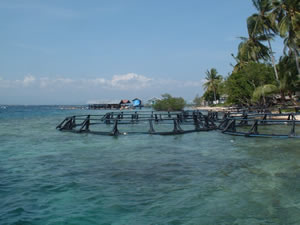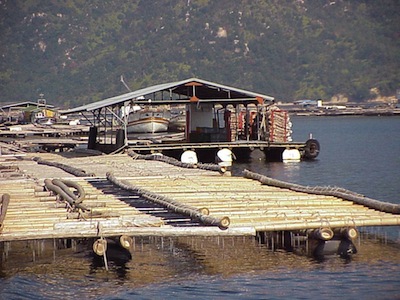
|
||||||||||
| Fisheries :: Marine Cage | ||||||||||
|
Pearl Oyster
Site selection criteria Selection of farm site is of a paramount importance. The selection would be based on the biology of the organism farmed and the ambience of the prevailing environmental parameters of the site. Congenial conditions such as protection, water current, clarity, optimum temperature and salinity regimens are to be considered while selecting the farm site, apart from the site being free from any kind of pollution. A deep sheltered bay/protected water bodies with sea conditions not going too rough offers an excellent site for pearl oyster farming. Farming Systems In India, the farming practices of pearl oyster is very much limited to the two Gulf zones ie., Gulf of Kutch in Gujarat and Gulf of Mannar in Tamil Nadu. The method of farming varies to the prevailing farm site conditions. Accordingly the following methods are developed and practiced. Rack culture system Rack culture system is very much suitable for areas of shallow depths ranging from 2-5 m. In such shallow areas either casuarinas or teak poles of 4-5" thickness are driven vertically on the sea bottom. These vertical polesare interconnected with similar poles horizontally and lashed with coir ropes. The horizontal poles are so arranged in a way that they are just above the highest high tide level. Driving GI pipes of 4" dia on the periphery of the rack can provide reinforcement to the racks. Generally the racks are rectangular in shape. A working plat form at few places of the rack can also be provided by 6-8" wooden planks. A rack of 30 sqm can hold about 100 cages.
Long line culture system Long line culture system is practiced in the open sea where the depth is more. This is more suitable to withstand the high wind and wave action. Long line is primarily constructed with a long synthetic rope (15-20 mm) with two main floatsonboththeends. Dependingonthelengthofthelonglinesmallerfloatsisalsoattachedtothemainlineat5m interval. Vertical lines are arranged in 1- 2 m apart from the horizontal main line. Such line is moored in appropriate site with the help of 2 anchors. A series of such long lines are arranged horizontally. On shore culture system This system is of recent origin. Seeds of pearl oysters are reared in cement tanks of size ranging from 250-500 sqm. A water level of 1 m is maintained. Oysters are held above the bottom, through a grid system constructed using PVC pipes. A stocking density of 125nos/sqm is maintained. Raw seawater is pumped into the settlement tank and then to the rearing tanks. Stocked oysters are supplemented with mixed culture of Chaetoceros spp. Cell concentration in the rearing medium is maintained at 75,000 cells/l in the tank. Daily 25% water exchange is required. By this method an average growth of 50 mm in 6-7 months from a stocking size of 5.0 mm is achieved. Culture containers Spat transplantation cages This is type of cages is fabricated using the box cage iron frames. Suitable sized velon screen (0.5-1mm mesh) bags are prepared and the cage frame is inserted inside and both the ends are tied. Old fish net (10mm mesh) is stitched as bag and rolled over the velon bag. This provides the extra strength to the spat cages. A central rope is provided and folded in the center so that the cages are hung horizontally in the culture structures. A stocking densityof about 1000 nos/cage (3.0mm spats) can be maintained for short period. The small meshed velon screen bag has to be replaced with large meshed velon screen bags every 15 days as the spat grows. Clogging takes place very quickly in these cages and hence periodical cleaning is very essential to avoid mortality. Culling has to be done as the spat grows.
Lantern cages Lantern cages are fabricated using circular iron frames of 4 - 6 mm rod arranged in 2-3 layers. Plastic sheath can be provided over the iron rod for longer life of the cages. Appropriate sized mesh is stitched over the frame. An opening is given at each layer to handle the stocked oysters. The cages are vertically hung in the culture structures. Farm management Major problems in the maintenance of pearl oyster stocks in the farm are the biofouling organisms. These organisms settle and grow on the shells, the boring organisms riddle through the shells and render them weak and fragile to predators. These factors either singly or combinedly can affect the farmed stocks or result in growth retardation and mortality. Fouling The most dominant fouling organisms in pearl oyster farming is barnacles (Balanus amphitrite), bryozoans (Membraniforasp,ThalamoporellaspandLageniporasp.). SimpleascidiansAscidiadepressiusculaandDicarpasp and compound ascidians Diplosoma sp and species of Botrilloides were found to settle and encrust upon the oysters. The profuse growth of sponges Callyspongia fibrosa and Haliclona exigua results in complete covering of an oyster or a cluster of oysters. However, the frequency of occurrence of this kind of foulers is very less. Boring The dominant groups of boring organisms are the sponges and polychaetes. Polydora ciliata, Polydora flava and Cirratulus cirratus are the major borers and causes mortality. Cirratulid worms inhabited the pearl oyster shell in between the layers of periostracum. As a result the furrow becomes deeper by the accumulation of mud and thus causing peeling of periostracum making the shell weak. Members of the family Syllidae, Nereidae and Terebellidae burrow through the shells and causes extensive blisters in the nacreous layers. Cliona vastifica and C. celata form honey comb like ramifications in the shell with numerous openings on the nacreous surface. Such affected oysters suffer great physiological strain in repairing the shell and latter leading to mortality. Boring mollusks such as Lithophaga sp, and Martesia sp which make holes on the shells are also occasionally found on the oysters. Predators The gastropods Murex virgineus and Cymatium singulatum are the most important predators on the farmed oysters. They can consume at a rate of one oyster/day/animal. Crab species like Charybdis lucifera and Atergatis integerrisimus also prey upon the oysters in the farm. Sometime Xancus sp are also found to prey on oysters in the cages. The boring and fouling organisms can be killed by applying a number of chemicals in appropriate dosages on the individual oysters. However, in the farming conditions the best method of controlling the boring and fouling organisms on the farmed oyster is thorough periodic cleaning by scrapping off the borers and foulers. Predatory molluscs in the cages can be picked and killed. By following the judicious choice of depths for growing oysters can also avoid such problem, as the fouling in deeper waters is relatively less. Updated on Feb 2015 |
||||||||||
© All Rights Reserved. TNAU 2009-15. |
||||||||||

